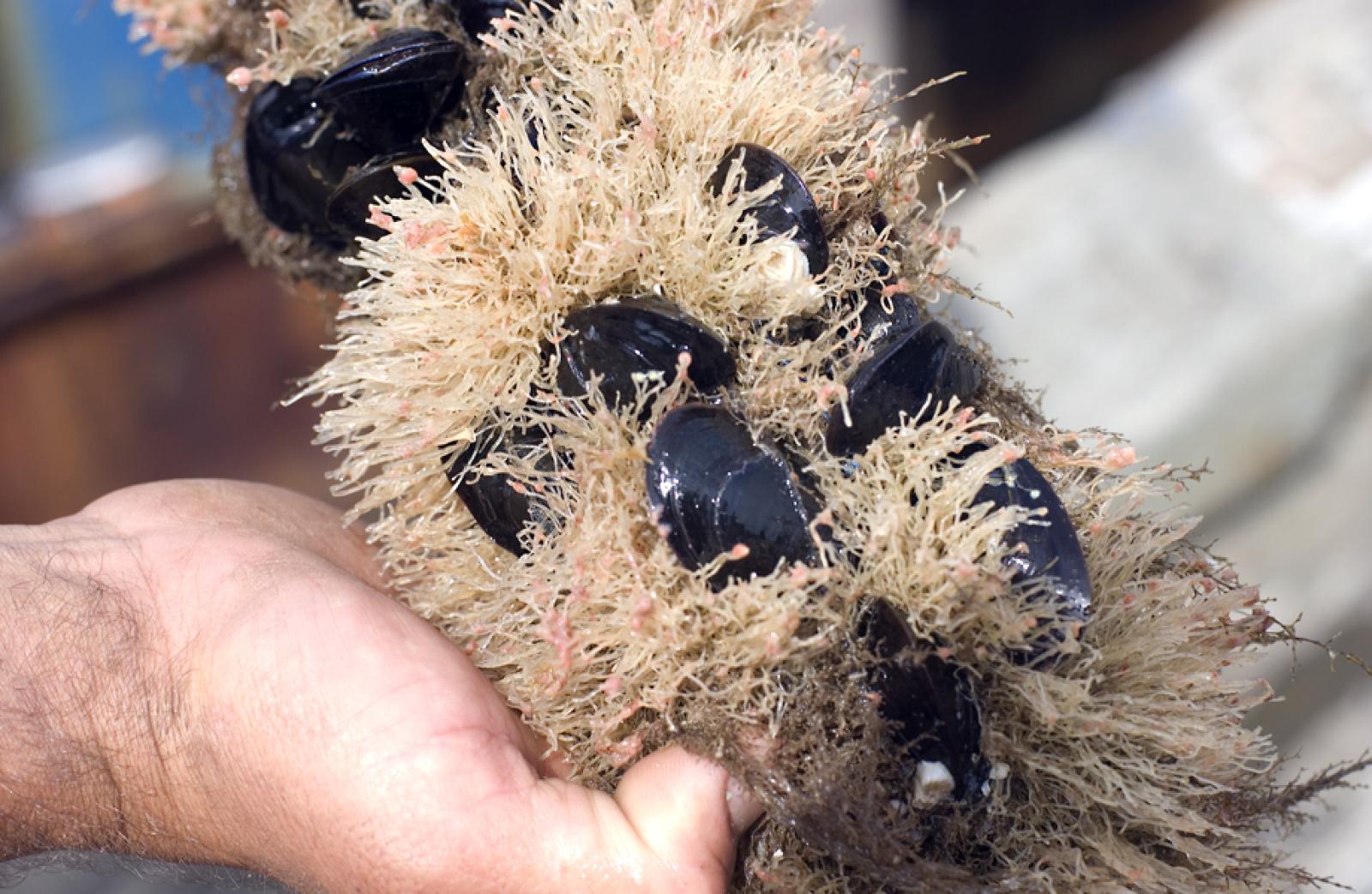The first blue mussels on the experimental offshore mussel farm in Vineyard waters will be harvested in the coming weeks. The mussels are large enough to go to market, according to Scott Lindell, an aquaculture specialist with the Woods Hole Marine Biological Laboratory.
There are two small farms. One is north of Chilmark; the second is west of Noman’s Land. Two Island fishermen, Alec Gale of West Tisbury and Tim Broderick of Chilmark, are tending the farms with a 55-foot workboat, the Jane Lee, out of Menemsha.
Mr. Lindell is a marine resources manager and director for scientific aquaculture programs for MBL. He is the principal investigator for this experimental project, backed by a $214,000 marine aquaculture initiative grant from the National Oceanic and Atmospheric Administration. The two-year project involves two growing areas, one south of Rhode Island and the other off the Vineyard. In each place, two fishermen are working the farm. A wholesale shellfish processor, American Mussel Harvesters Inc., based in Narragansett, R.I., is also involved.
“This project holds tremendous promise. We in the United States have been slow to take to mussel farming. We buy our mussels from overseas. A lot come from Canada and plenty come from Prince Edward Island, New Zealand and Chile,” Mr. Lindell said.
The mussel farm is made up of long lines suspended deep in the water column. The mussels grow on the lines. They need little attention, although weather and rough seas can affect the equipment. “It is all going well biologically, though there is a large learning curve, to operate in the open ocean,” Mr. Lindell said.
One of the challenges has nothing to do with aquaculture. In both Rhode Island and the Vineyard, the mussel farmers are having a time trying to establish marker buoys that boaters can see and avoid. “We are trying to get the cooperation of local fishermen to steer clear of the buoys. We also have buoyancy issues,” Mr. Lindell said.
The lines become heavier as the blue mussels grow, and a system is needed to keep them off the bottom.
So far there have been no problems with pea crabs, tiny crabs that live inside wild blue mussels, lowering their market value. Mr. Lindell said the blue mussels growing on the experimental farms are nearly crab free — about one in 200 blue mussels has a pea crab.
Mr. Lindell believes this is because the mussels are growing in fast-moving water, never touching bottom, and therefore free from predators.
The only other known threat to the mussels is the eider, a duck which eats them and is capable of swimming down 50 feet to get a meal. But for now, the harvest of the first blue mussels offers hope for an emerging aquaculture fishery. The grant runs out at the end of the year. Mr. Lindell hopes the success of the project will attract more local fishermen and investors.
Conch and Sea Bass
The summer conch fishery is winding down. A number of local fishermen report poor landings and a lackluster season. The water has been warm this year and this has affected the conch fishery. Conch are harvested in pots that look like lobster pots.
Capt. David (Tubby) Medeiros, 46, an Edgartown conch and lobster fisherman, said he is hauling his conch pots for the year. “The conch are under so much pressure, it is ridiculous,” Mr. Medeiros said. “It seems everyone and their grandmother is fishing. The water temperature is up eight degrees compared to last year, but I think the biggest thing is [fishing] pressure,” he said. Captain Medeiros fishes in the Billie H.
The commercial sea bass fishery opens August 1, but don’t wait too long if you want to catch and eat one. Black sea bass are a prime chowder fish. They are often baked whole in the oven. The Chinese love them.
The quota in Massachusetts is 228,619 pounds; 209,113 pounds already have been harvested earlier this year.
With such a low quota, Captain Medeiros declared it a waste of time to fish for black sea bass. He predicted the quota will be taken within days.
Dan McKiernan, deputy director of the state Division of Marine Fisheries, said while it is true the quota is small, he believes the season will last longer than a few days, maybe two weeks.
Rod and reel commercial fishermen can benefit from the opening. Pot fishermen who are targeting another species may benefit if they find a black sea bass in their traps.
Commercial fishermen are limited to a minimum size of 12 inches and a daily bag limit of 50 pounds. Local fish markets may have some freshly caught sea bass on ice.
For recreational fishermen pursuing black sea bass, the season runs until Oct. 11. The minimum size is 12.5 inches and the bag limit is 20 fish per day.
Black sea bass are caught the same way as fluke, with a weighted hook on the bottom. Squid is favored as bait.
Slow Year for Striped Bass
The striped bass season has been slow; even the charter fishermen are wondering where the fish are. Many blame the warm water temperatures. “I hope that is the problem,” said Cooper A. Gilkes 3rd, who owns Coop’s Bait and Tackle Shop in Edgartown. “Although I am a little nervous,” he said. He had a conversation with his fishing friends in Maine, where the water is colder, and even Maine has few fish.
Capt. Dick Vincent is back on the Vineyard doing charters. The captain, who with his wife, Susan, moved permanently to Naples, Fla, has returned for a summer of fishing. He too said the bass are scarce. “Fishing has been slow compared to years past,” the captain said.
As a result, Captain Vincent has been doing more trips offshore. He fishes out of Vineyard Haven on the Blackout, a 35-foot SeaVee 340i.
Many will remember Dick and his boat Flashy Lady, working out of Menemsha. Her plans to stay through the derby in the fall. The fishing is best here in the summer, he said. Later he’ll head back to Naples. The only hard part, he said, is that he misses his wife.
And finally, here is a fishing news flash: The first bonito was caught last weekend. Carol Koser of Porky’s Bait and Tackle Shop called to report that her husband caught a bonito on a charter off Wasque, a 9.5-pound fish, on Saturday morning.






Comments
Comment policy »